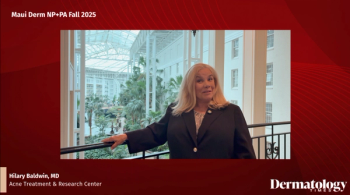
New NRS Recommendations for Rosacea
The National Rosacea Society has recently released recommendations based on a group discussion regarding updates in rosacea.
An article published in the
The article was based on a National Rosacea Society (NRS) discussion about this key symptom came up after the recently updated standard classification system, standard management options, new burden-of-illness study results, and significant advances in care.
The discussion was led by Richard Gallo, MD, PhD, chair of dermatology at the University of California-San Diego, in San Diego, California, and included Hilary Baldwin, MD, associate professor of dermatology at Rutgers Robert Wood Johnson Medical School, New Brunswick, New Jersey; Julie Harper, MD, president and owner of the Dermatology and Skin Care Center of Birmingham, Vestavia Hills, Alabama; and Linda Stein Gold, MD, director of dermatology clinical research at the Henry Ford Health System, Detroit, Michigan.
“Based on current scientific knowledge and clinical experience, rosacea is now classified as a single disorder with many potential phenotypes (signs and symptoms) that may occur in various combinations, with persistent facial erythema as the primary diagnostic sign,” said Gallo. “Combined with study results showing the substantial psychological and social impact of facial erythema alone, these important findings have clarified our understanding of how and why all signs and symptoms of rosacea should be effectively managed for optimal patient outcomes.”
If any of the two phenotypes are present (i.e. erythema, skin thickening, papules, pustules, flushing, telangiectasia, and certain ocular manifestations) they may be considered diagnostic, according to the article. The secondary phenotypes include burning, stinging, edema, and dryness.
According to the article, research has suggested that rosacea’s initial redness is likely because of inflammation, which can cause other issues, and medication to treat inflammation may be useful for treatment. Data collected in NRS surveys as well as in burden-of-illness studies showed that persistent facial redness, though often dismissed by physicians as a less serious phenotype, has a significant impact on sufferers’ quality of life, often comparable to the impact of eczema, atopic dermatitis and psoriasis.
In a
The FDA has approved 2 therapies specifically for erythema caused by neurovascular dysregulation in rosacea, brimonidine and oxymetazoline, which are both alpha agonists.
According to the research3, while brimonidine does work relatively fast, within 30 minutes, some patients complain of over-whitening of the skin, and it has been noted that exacerbations of redness can occur. While on the other hand, oxymetazoline has a peak reduction of erythema at 3 hours, lasting through a 24-hour period then returning to baseline and the exacerbation of erythema was not reported.3
A combination of therapies can be used to treat the different symptoms, such as anti-inflammatory treatments for redness around papules and pustules or light devices in removing telangiectasia and reducing erythema. The roundtable agreed that treatment the present phenotypes with target therapies would achieve the best outcome instead of using a singular method. They also emphasized educating the patient on compliance as avoiding triggers, regular treatment use, and lifestyle changes may be needed to properly treat the rosacea.
The roundtable was made possible by an educational grant from EPI Health.
Reference:
1. New publication updates physicians on facial redness in rosacea. Rosacea.org. Published August 23, 2021. Accessed September 13, 2021.
2. New rosacea survey shows emotional toll of facial redness equals impact of bumps, pimples | rosacea. Org. Published January 15, 2015. Accessed September 14, 2021.
3. Gallo RL, Baldwin HE, Stein Gold L, Harper JC. Update on Facial Erythema in Rosacea. J Drugs Dermatol 2021 Aug 1;20(8). Published online July 19, 2021. Accessed September 14, 2021. DOI:10.36849/JDD.6062
Newsletter
Like what you’re reading? Subscribe to Dermatology Times for weekly updates on therapies, innovations, and real-world practice tips.

















